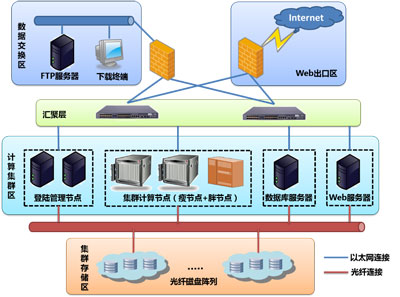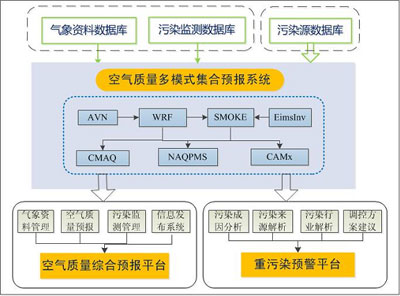
Welcome to Login
微信登录
打开手机微信,扫描二维码

扫描成功
请勿刷新本页面,按手机提示操作

中科曙光不会以任何理由要求您转账汇款,谨防诈骗

您的微信还未注册

中科曙光不会以任何理由要求您转账汇款,谨防诈骗
您可以同时关注中科曙光微信公众号
使用微信扫一扫即可登录! 查阅资料更方便、 快捷!
您已经注册账号和
关注微信公众号

2025年1月
服务热线:400-810-0466

Met-ocean and Environment
From day-to-day weather forecasting to large-scale climate research, from land to sea, from surface hydrometeorology to space weather, Twilight's high-performance computers are active. Sugon's “send” super-calculation system for the National Meteorological Administration represents the super-calculation system. Beginning to lead China's own meteorological research work, while Sugon provides technology, products and solutions for the promotion of "smart weather".
1. Demand analysis
Since “the Eleventh Five-Year Plan”, China has increased force on air pollution regulation; concentration of conventional pollutants such as SO2, NO2 and PM10 has continuously declined, but with the rapid development of economic society, energy consumption increased sharply, motor vehicle ownership improved dramatically and emissions of social pollutants have show significant growth. Under the circumstance that pollution problem of PM10 and TSP has not been completely solved, pollution of PM2.5 and ozone in some areas aggravated with frequent occurrence of ash haze phenomena. Especially since October 2012, the ash haze weather occurs even for several days in succession in central and eastern regions of China, but our country’s current ambient air quality standard is relatively loose, which leads to big differences existing between the monitoring data of air quality published in regions and public senses, and the ash haze problem becomes the focus of extensive attention from all walks of life.
On Feb. 29th, 2012, “ambient air quality standard” was launched by Ministry of Environmental Protection; the new standard has added monitoring indicators of eight-hour concentration limit of PM2.5 and ozone, which requires stricter on concentration limits of NO2 and PM10; the new evaluation system is further in line with international standards and realizes the consistence between air quality evaluation result and people's personal feeling, but also comes up with higher requirements on the control of air pollution in China.
Air quality forecasting method is generally divided into two kinds--traditional statistical forecast and new numerical forecast. By making use of existing historical monitoring data, traditional forecast makes prediction and early warning based on statistic analysis and studying on the changing rule of the atmospheric environment, and it’s widely used in forecast currently. However, because it’s based on statistical concept, which is hard to quantitatively analyze the data of each component. Moreover, it does not take influence of changes in sources of pollution into consideration. Based on the understanding of rules of atmosphere’s physical and chemical process, numerical forecast employs mathematical method to do the simulation. Numerical prediction and forecast completely considers atmospheric processes, even the conversion between different media, fully simulating transmission of pollutants in various scales. It not only considers the influence of changes in sources of pollution, but also is more convenient to track the impact from sources of pollution on air quality, which provides scientific basis for decision makers; it is the development direction of air quality forecast and early warning.
Regional air quality mode is the core of numerical forecast and early warning on air quality. Taking the results of meteorological mode as its driving field, based on the emission list of pollution sources, it predicts the concentration data of all kinds of pollutants for a future period of time through regional air quality mode, and also calculates related conditions of regional and grid air quality on this basis. At present, the most commonly used modes in atmospheric environment are MODES-3/CMAQ, CAMx, ADMS, CALPUFF, AERMOD and NAQPMS of Institute of Atmospheric Physics, Chinese Academy of Sciences. Among which, the calculating main modes of MODES-3/CMAQ and CAMx are completely parallelized, so the calculated amount needed is relatively large, while ADMS, CALPUFF and AERMOD are serial programs, so ordinary workstations are competent enough.
At the end of 1990s, based on a concept of atmosphere, the U.S. Environmental Protection Agency developed the third-generation air quality mode system (Modes-3 CMAQ), which is multi-module integration and multi-scale nested grid and is a new-generation air quality mode system representing the development direction of modes; it adds feedback effects between chemicals and meteorological elements, which realizes simultaneous simulation for many species (such as ozone, SO2, acid rain and aerosol). The description of atmosphere’s physical and chemical processes is more comprehensive and delicate. There are functions of decision support and research on coupling atmospheric physics and atmospheric chemical kinetics in the mode system, which is an atmospheric quality early-warning management system that closely connects air quality forecast with air quality assurance and decision support system of pollution control. The third-generation air quality mode system is an extensively applied mode in environmental field, while its operation also supports parallel mode with good extensibility.
2.Solutions
As to the application needs on environmental quality mode of environmental protection departments, Sugon Company provides a specific high-performance and professional cluster solution, the whole topography of which is shown in the following figure:

The whole set of the cluster solutions includes several parts such as data exchange section, Web exit section, computing cluster section, cluster storage area and network of convergence layer. Data exchange section covers FTP server and downloading terminal, in charge of downloading and collecting meteorological data and data of pollution source, providing input data for calculation of computing cluster environmental mode. Web exit section offers external interface of data, for data downloading and release of mode results. Computing cluster section is the core of the whole scheme, including high-performance computing node, login management node, database server and Web server etc, realizing a series of operation flow such as data processing and saving, calculation of environmental mode and results generation and release. At the bottom of the cluster is the high-performance fiber-optic storage system of SAN architecture, using the parallel file system to provide a huge number of data storage space and high-speed concurrent read-write performance.
As to establishing numerical forecast platform for air quality, Sugon provides solutions of multi-mode ensemble forecast of air quality as shown in the following figure, which adopts ensemble forecast with three main air quality modes of CMAQ, CAMx and NAQPSM. The platform carries five functions:

1、Meteorological data management: major function of meteorological data management is to collect, reveal and analyze all meteorological data needed for air quality forecast and early warning, including data in text and image.
2、Pollution data management: set up pollution database and lead in pollution monitoring data of historical facts. According to demands, it implements statistical analysis functions such as year-on-year and link relative historical pollution data, and realizes functions such as query and analysis on historical data of pollution process in an arbitrary period of time in history.
3、Air quality forecast: forecasting function includes forecast of regional pollution form and station air quality forecast, with forecast pollutants covering PM10, SO2, NO2, O3 and PM2.5 etc. It separately provides concentration forecast by hour and 24-hour average forecast in the following three days in the area.
4、Source tracking and analysis: based on analysis on causes of heavy pollution in environmental air and pollution sources, it provides data support for making economic and efficient pollution control scheme.
5、Release and display: through heterogeneous data space, it processes the middleware and optimizes the result data on calculation results of the mode, real-time monitoring data and meteorological elements’ information, as well as extracting, processing and organizing and managing the result data.
Multi-mode ensemble forecast platform for air quality is specific to the integrated, automatic and low-cost solution provided by environmental protection departments. The platform integrates air quality forecast, analysis, decision support and release, adopting a variety of the latest technologies such as data assimilation, analysis on pollution source, pollution source tracking, elaboration and disturbance of emission source and multi-mode integration, which help improve the accuracy and operational function of the system, meet demands of the new national standard by offering concentration of seven indicators in six pollutants (SO2, NO2, CO, O3, PM10 and PM2.5), and effectively helps professionals to improve operational efficiency through intelligent processing modules.
Dawning Information Industry Co.,Ltd. Sugon Building, No.36 Zhongguancun Software Park, No.8 Dongbeiwang West Road, Haidian District, Beijing 100193
Tel:+86 400-810-0466
Fax:+86 10-56308222
E-mail:international@sugon.com
Dawning Information Industry Co.,Ltd. Sugon Building, No.36 Zhongguancun Software Park, No.8 Dongbeiwang West Road, Haidian District, Beijing 100193
Tel:+86 400-810-0466
Fax:+86 10-56308222
E-mail:international@sugon.com



 Register /
Register /